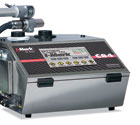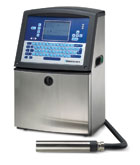
Coding equipment boosts its reading, writing and track-and-trace capabilities.
Whether they’re printing alphanumerics or bar codes on primary or shipping containers, today’s coding and marking technologies are improving code quality to enable easier human and machine readability. This, in turn, is essential to implementing and/or automating a traceability program to help improve food safety.
Small, clear and fast
Today’s packages seem to be getting smaller, whether it’s convenient single-serve packs or for sustainability reasons. Thus, the available space for any kind of code is shrinking. And food and beverage packagers are on the hunt for more efficient ways to identify products throughout the supply chain.According to Bob Neagle, brand protection solutions business unit manager at Videojet, customers are asking for a 2-D Data Matrix GS1-compliant bar code to help create trackability through the supply chain. (GS1 is the new name for the Uniform Code Council, the organization responsible for setting industry standards and assigning universal product codes [UPCs], among other services.)
Michael Shaw, Nutec’s vice president of sales, agrees.
“Most companies have realized through extensive pilot line testing that 2-D Data Matrix codes are the best approach for product serialization at the unit level, both from a cost and readability perspective,” Shaw says.
However, a smaller and more detailed code poses a challenge: how to increase print quality while facing uptime demands. Coding equipment makers are responding with systems that can print large amounts of data in small spaces-both clearly and quickly.
“It takes our core coding technology and ability to put pretty much any type of code on any type of substrate in any type of environment to create item-level serialization that can create the supply chain history customers are looking for,” says Neagle.

Matthews' C-84 continuous ink jet printer prints expiration dates, batch codes, logos and bar codes on both porous and non-porous substrates.
Primary package coding
Several different coding technologies can print crisp codes on a variety of primary packages, including continuous or thermal ink jet and laser.Videojet has released the 1510 small-character continuous ink jet (CIJ) printer, designed for printing codes for roughly 16 to 20 hours per day, six days per week. It also features Smart Cartridges, which are fluid bottles with a microchip that identifies whether compatible fluid has been installed. To help ensure quality prints, the printhead adjusts automatically based on environmental changes.
Matthews’ C-84 CIJ printer also works well for primary packages, particularly with contoured bottles, printing up to four lines of text from 0.05 inches to 0.61 inches high at up to 1,050 feet per minute.
For an alternative to CIJ, Nutec’s apsolute uses a simple print cartridge and thermal ink jet technology, complemented with fast-dry multi-substrate ink, to print on a variety of surfaces at resolutions up to 600 dots per inch (dpi).
Of course, ink is the lifeblood of printing technology, and also determines print quality. According to Trace Bocan, marketing manager at Matthews Marking Products, not only is coding technology advancing to offer better quality marking, but new ink formulations and features figure largely into the advancement of higher resolution marking. Better solvents, pigments, dyes, colorants and other agents help formulate more coding options than ever before.
But for companies looking to eliminate ink cartridges altogether, laser coding offers crisp and clear marking without the ink.
Diagraph’s Linx SL101 and SL301 laser printers offer speed and sharp print. Its digital signal processing ensures that the speed of the mirrors steering the beam is optimized, which provides quality printing at line speeds up to 984 feet per minute. The print doesn’t rub off or fade, either, which offers increased security.

Diagraph's Linx SL101 and SL301 laser coding equipment, with its range of lens and beam delivery options, is able to print codes in hard-to-reach places.
Secondary package coding
On the secondary packaging front, even though there might be room for larger, linear bar codes, companies are still interested in keeping codes as small as possible while still maintaining readability.“Generally, when it comes down to unique identifying numbers, the longer the number, the longer the bar code,” says Jacki Goodall, Diagraph’s product manager.
For smaller printing capabilities, Matthews’ IP 7000 prints high-quality text, logos, graphics and bar codes on two sides of cartons and trays at heights between 0.08 inches and 3.94 inches. It also offers low ink consumption and minimal maintenance.
Regular cleaning of the printhead helps keep codes crisp. Videojet’s 2320 large-character ink jet printer prints on corrugated shipping containers for applications requiring code heights up to 2 inches. Its self-purging head leads to clearer print quality that is easier to read.

Videojet's IMprints track-and-trace technology protects brands from counterfeiting and diversion, and helps simplify recalls.
Tracking the threat
A company can never take too many precautions when securing its brand image. And, with the marketplace becoming more global, the need for consistent track-and-trace technology is more crucial than ever.“As imports increase to the U.S. from other countries, standardization of coding guidelines is important for keeping food and beverage products safe,” says Bocan.
Since safety is a concern, what precautions are companies taking? Well, like a car owner protecting her car with Lo-jack, companies are looking for electronics that can immediately pull up a supply chain history of a product. This is useful on two levels: (1) making sure the product isn’t diverted from where it needs to go and (2) protecting against counterfeiting.
“One of the reasons everyone wants to go to electronic documentation is because when you have a paper trail, numbers can be falsified and documents can be rewritten,” says Goodall. “If it is electronic and a truly unique identifier to a product, [then it] is the most secure that you can make your product or the supply chain.”
With its IMprints track-and-trace suite, Videojet is able to create unrepeatable alphanumeric linear bar codes or Data Matrix codes that cannot be copied. Its Line Controller hardware and software coordinate production line activities, including the variable data marking/coding equipment and a Cognex camera system. The inspection system verifies the printing of a valid code. A code linked to them is then printed on the shipping case, which is documented by a scanner, and the pallet is labeled and documented by a scanner, as well.
All data that’s collected throughout the supply chain will come back to the customer, which gives end-users a way to refer to that data to find out where the product may have gone astray.
This also helps to reinforce brand protection. For example, if a rare vintage bottle of wine showed up on the shelf in a bargain liquor store, the wine brand’s image could potentially suffer damage.
Like the Sam Spade of coding technology, Videojet helped a customer that had distributors that did not stay in their own territories, which made them subject to severe fines. But the customer needed proof of the situation.
“We know the codes that are supposed to go to an individual distributor,” says Neagle. “This is helpful when a company investigates and figures out, ‘Wait a second; this code that’s in New York came from this guy that’s in New Jersey. How’d it get here?’ Then, the company can turn around and show proof that the distributor actually sold outside of their territory.”F&BP
FOR MORE INFORMATION
The following companies contributed to the research for this article:Cognex Corp.
508-650-3000
Diagraph Corp.
800-722-1125
Matthews Marking Products
412-665-2500
Nutec Systems Inc.
609-912-0145
Videojet Technologies Inc.
800-843-3610

Though it fits in about the same size space as a PLU number, the GS-1 DataBar has the ability to deliver the entire supply chain history of a product.
SIDEBAR: GS-1 DataBar: A window into the future
Produce growers and shippers are starting to replace Price-Look-Up (PLU) stickers with the GS-1 DataBar bar code, which is designed for small item identification, smaller than EAN-13 or UPC-A, and printable on loose fruit labels. While PLU stickers only identify the commodity variety and size group of an item, the GS-1 DataBar keeps a record of what products came from what grower or shipper, and can determine if the product is on recall or has exceeded its expiration date.With the recent produce recalls due to Salmonella Saintpaul, the GS-1 DataBar could prove to be useful in its ability immediately spot a bad product and trace it back to its point of origin.
First known as the Reduced Space Symbology (RSS) code, the GS-1 DataBar gained use in the pharmaceutical industry due to its ability to fit a bar code on a label with limited space (a syringe or vial, for example). It has since expanded into the produce market to be printed on loose fruit and vegetable labels. Its popularity with other fresh commodities is showing strong growth potential.
“The potential for growth is huge,” says Gary Fleming, Produce Marketing Association’s vice president of industry technology and standards. “It has already started with Wal-Mart in the U.S. and Loblaw’s in Canada, and it’s moving to a few other retailers, including Wegman’s and Kroger.”
